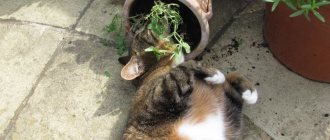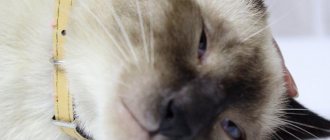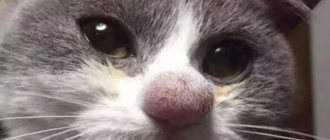Business lawyer > Starting a business > Business ideas > Breeding cats as a business: advantages and disadvantages, rules of care, ways to make a profit
Today, many people are concerned about the question of how to combine their favorite hobby and earning money to meet their needs. Because of this, many different business ideas have emerged, distinguished by originality and creativity. Breeding cats is considered one of the most profitable and at the same time interesting types of entrepreneurial activity, but for such an activity to truly bring profit and pleasure, several important aspects must be taken into account.
How to choose a breed for breeding?
First of all, choose the one you like. Just keep in mind - the more exotic the breed, the more the breeding kitten costs and the greater the chance that you will come across an animal with problems. Inbreeding is a delicate matter, and some hereditary diseases are not immediately detected. A rare breed means either very close inbreeding or the purchase of a manufacturer abroad.
There are breeds of cats in which a predisposition to certain diseases is inherited from their parents. Therefore, be sure to find out whether the breed you have chosen has such a problem and whether the owners of the breeders carried out the necessary tests. For information, go to breed forums, felinologist courses on a particular breed, or to veterinarians.
General information
Finding simple income
Therefore, only a large nursery can count on an acceptable profit. For private breeders, cat breeding is more like a self-sustaining hobby than a stable income for a living.
We bought a cat or cat and decided to start breeding
It is not uncommon for communication with your purebred pet, its success at exhibitions and flattering comments from friends to suggest that such a beautiful animal must breed. On the one hand, show champions are regularly invited to breed, especially if they are males. Kitties often remain on the sidelines, since bearing and feeding offspring is work that not every cat owner undertakes.
On the other hand, the success of a cat at shows and his external charm sometimes does not mean at all that he can participate in replenishing the breed base. Sometimes a seemingly ideal cat has hidden genetic diseases that are revealed in the very first litters of kittens and it is obvious that it is impossible to continue breeding with this particular animal.
The cat has to give birth, it's for health
This statement is a myth generated by elementary ignorance. The cat does not have to give birth; there is even nothing wrong if she was sterilized before her first heat. Domestic cats do not pursue the goal of preserving the population, like yard and ownerless cats, because they die on the street faster than domestic cats die, which means that if they do not give birth, they will disappear as a species.
Domestic cats, and especially purebred ones, are not under threat of extinction. They don’t need to give birth “just to have it”; a one-time litter does not affect their future health in any way.
It is even recommended to castrate cats, because their regular rutting is a problem not only for the owner, but also for the animal itself, which suffers from the play of hormones.
I bred hamsters, it's time to start cats
The breeding of each animal species has a number of categorical differences from each other. Starting to breed cats, even if you have already been breeding dogs, is not at all the same thing. Moreover, the experience of breeding ferrets, hamsters, and guinea pigs in “kitten production” is completely inapplicable.
“I have repeatedly kept cats of the same breed, I have exhibition experience, I know many like-minded people and I want to contribute to the development of the breed’s studbook or develop a new hybrid”
Business advertising
If your pets are ready for sale, you should conduct a competent advertising campaign. There are several options to help you inform potential buyers.
Advertising in the media. You can place an ad in the newspaper for the sale of purebred cats. The advertisement should include detailed information about the breed, the cost of the kitten, and contact numbers to contact you.
Internet advertising. You can place your ad on a popular website. Most people look for information about purchasing animals there. You can also create your own website selling purebred cats.
Selection of the number of animals and mating
If you decide to limit yourself to one pair, then this will not bring much profit, since the females need a rest from childbirth, but during this break there will be costs for food and care. In this case, it is necessary to calculate the number of animals that will be able to produce litter throughout the year. In general, it is recommended to carry out no more than two matings per year for one female, and the very first mating for a young cat - no earlier than after the first 3 heats. Pregnancy lasts about 2 months and depends on the characteristics of the breed. There can be 6 kittens from one mating, and for Maine Coons even more.
There are several options for purchasing breeding pairs:
- Buying kittens. In this case, you need to pay special attention to choosing a nursery so that by puberty you get what you wanted to see.
- Buying cats and cats that have already grown up. Their age should be no more than one year.
- Purchase of only females with further payment for mating. The more elite the male, the more expensive the mating. Usually its cost is 500-800 dollars.
For mating, it is worth setting aside a separate room if you have cats, since mating is usually carried out in the territory of the male. The mating itself lasts from 3 days to a week. To organize it, it is necessary to draw up a purchase and sale agreement between representatives of the bride and groom, which will stipulate the conditions, payment and the possibility of dressing in the event that the cat does not become pregnant immediately.
If pregnancy, fortunately, has occurred, then the future mother cat will need good care - high-calorie and vitamin-rich food, as well as a quiet and secluded place where she could rest. It is important to keep a diary of the dates of estrus and mating so that you are prepared for the female to give birth.
What should you do first?
- Visit an exhibition where as many cats of your breed are presented as possible. Take a closer look at the manufacturers, talk to the breeders. Don’t take money so you won’t be tempted to buy a kitten right at the show! Get to know the breeders better, write down the coordinates of the ones you like, check the prices for kittens and the terms of purchase.
- Go to the pet store's website. Look at scratching posts, beds, and other accessories for cats. Take a closer look at super-premium food. Find out prices, read reviews. Make a list of preliminary expenses.
- An optional, but desirable option is to take a felinologist course at a large club that has a specialist in your breed. During the courses, you will find out all the subtle points. Ask veterinarians, who often conduct seminars on the basics of veterinary care at such courses, to find out the prices for treatment. Get a certificate.
If there is no desire to run away, the first stage has been completed. And only now go get the kitten.
What to pay attention to
Decor
Pedigree cats, unlike yard cats, are demanding when it comes to food, rest and entertainment. You will not be able to leave the breeding female dry food in the morning and leave the house until the evening. Poor diet and quality of nutrition will affect her health, and at the same time the income from future offspring. Even the color and smoothness of the coat largely depend on the care of the pet.
Most breeders do not register their business, because there is not a word about nurseries in the legislation. Unregistered business activity is illegal, although in the case of cat breeding it is almost elusive and difficult to prove. Moreover, for most breeders this business is not the main one, but only brings additional income. Among them are professional veterinarians, farm and pet store owners. They just need to include the corresponding OKVED in the documentation.
Those who take on a business as their only one should seriously think about the risks.
Choosing a breed for breeding
There are over 100 species of purebred cats, but only some are in demand and suitable for a cattery (especially if it is domestic). Elite breeds are more expensive and require more expenses, and due to their high prices they are not in demand. The most common breeds for breeding are:
- Scottish fold (5-40 thousand rubles per kitten).
- Maine Coon (15-50 thousand rubles per kitten).
- Bengal (10-50 thousand rubles per kitten).
- British longhair and shorthair (10-50 thousand rubles per kitten).
- Manx (on average 30 thousand rubles per kitten).
- Sphinx (5-35 thousand rubles).
The price depends on color, coat length and other things. To properly organize a business, you should not take on breeding more than two breeds at once - analyze the characteristics of different cats, study demand, prices, estimate the costs in advance and make a choice.
Nursery premises
Without additional finances, you can keep stud cats and offspring in your home (ideally in a private home, fresh air and the opportunity to walk have a positive effect on the health of the tailed cats). In any case, it is necessary to allocate a separate room for living, development and recreation. There are beds, drinking bowls, bowls, scratching posts, educational paths, toys, and horizontal bars.
If you purchase several cats or even pairs, consider zoning the room, since a female who has given birth with kittens should be located separately. For several months to six months, the cat should not be allowed near her.
Necessary costs and actions
Many novice breeders stop after their first attempt at breeding cats and move on to something else. The reason is high costs, often not recouped, which must be borne one-time or regularly:
- Producer female. Its price depends on the breed, age, pedigree. From 15-20 to 100 thousand rubles.
- Mating or male for mating (when buying a cat, you will need to double the fixed maintenance costs) - up to 50 thousand rubles. However, if you know someone you can find a free option.
- Food (about 10-20 thousand rubles per year per animal) + complementary feeding of kittens before sale.
- Trays, fillers (2-3 thousand rubles per year).
- Tools and care products (nail clippers, shampoos, brushes, special baths).
- Medicines for prevention and treatment (for fleas, worms, lichen).
- Veterinarian services and vaccinations. Routine examinations, ear cleaning, tests are a prerequisite for breeding cats. On average, you will spend 1-2 thousand rubles per visit. Vaccines are given to kittens 2 times after birth (about 1.5 thousand rubles), a veterinary passport is issued, annual vaccines for breeding cats cost up to 1 thousand rubles. Treatment costs are difficult to predict.
- Participation in exhibitions (without them you will not be able to breed cats, since this is where experts evaluate animals and give diplomas). Participation price – from 2 to 25 thousand rubles. + purchase of an exhibition stand or cage.
- Joining one of the “Cat Lovers Clubs” or registering a cattery in felinological systems (CFA, WCF) will cost approximately 1-1.5 thousand rubles. + annual fees. This is also mandatory, since it is these institutions that issue metrics and pedigrees for the offspring born to you. In addition, it is easier to find buyers through them.
Choosing a future manufacturer
Keep in mind that prices for pet, breed and show class kittens may vary. There is no need to try to save money by buying a cat “for the sofa” and then letting him breed. First of all, it's not decent. The breeder will be unhappy. Secondly, “for the sofa”, even with a pedigree, they often sell not the best representatives of the breed. Perhaps the animal has hidden defects. So look for a cat of at least “breed” class, and a cat of “show” class. The requirements for stud cats are stricter than for cats.
If you have already spent a little time among breeders, then you have probably found a suitable nursery that sells quality kittens. A kitten will be able to move to a new home only after reaching a certain age and having been vaccinated. But you can reserve the baby you like by paying a deposit. And be sure to conclude a purchase and sale agreement.
The kitten comes with:
- veterinary passport with a note on the vaccinations done (it is better if there are two records. If there is only one, you will have to take care of the second vaccination yourself);
- metric or pedigree, if the breeder has already obtained it on his own. If there is only a metric, the pedigree is issued by the club in which the litter was registered. Attention! Pedigree and permission to breed are two different things. The pedigree only confirms the origin of a kitten from parents of a certain breed, but not its breeding value;
- recommendations from the breeder on feeding, training, the best choice of doctor, etc. If possible, ask for them to be provided to you in writing. It is very easy to forget something important, and it will be easier for you later.
If you want to feed your kitten natural products rather than ready-made food, you will need special vitamin and mineral complexes that are added to the cat's food. They maintain the activity and resistance of the animal’s body to viruses, and normalize the balance of vitamins in the body. For example, the Radostin vitamin and mineral complex, produced in 5 types, can be used for additional care for a pet of any breed and age.
Cost of selling kittens
What affects the price of a sold animal?
- Fashion for a particular breed.
- Color and compliance with certain standards.
- How old or modern the breed type is.
- Prestige of the nursery.
- Titles and awards of ancestors.
Animals for breeding that belong to the “show class” are sold at a much higher price. This price is sometimes justified - representatives of this class have certificates and medals from specialized exhibitions for compliance with breed standards.
Representatives of the “breed class” are not considered champions, but can produce “show class” offspring.
There are cases when grown cats and female cats are unsuitable for breeding. In this case, the animal is sterilized or given away free of charge or at a minimal price. These are the so-called “pet class” cats, which should not be in the pedigree, and if you want to purchase an animal for breeding, you need to take this into account.
The best choice for starting breeding is purchasing “show class” animals. It should also be taken into account that animals for breeding are sold at a much higher price than just cats for the joy of home. But for breeding, you will need permission to reproduce and a pedigree passport.
In addition, it is necessary to take into account the purchasing power specific to your region.
Care instructions
If you have one or more cats at home, you need to be well versed in their needs. Thus, a responsible breeder needs to monitor:
- Vaccinations - every cat must be vaccinated against rabies and dangerous infectious diseases (calicivirus, distemper, rhinotracheitis) once a year. Also, before selling kittens, the breeder is responsible for carrying out the first vaccination for each of them and obtaining a veterinary passport. The cost of vaccines varies greatly depending on the manufacturer, for example, for a dose of Biofel you will have to pay about 250 rubles, and one injection of Nobivak Tricat will cost 500–600 rubles.
- Feeding - taking into account the purpose of purchasing purebred kittens and their value, food should be of high quality and healthy. When choosing ready-made food, you should give preference to the super premium class (1st Choice, Arden Grange). Natural nutrition is a more complex path, implying additional costs for the purchase and preparation of products. The diet must be balanced, it must contain meat, cottage cheese, eggs, vegetables, and herbs. The cat should receive all the necessary substances, regardless of its feeding style. On average, it costs about 1,000 rubles to feed one cat with high-quality food, and expenses for pregnant pets increase to 1,500–2,000 thousand.
When getting cats, the owner must understand that animals must be fed only with high-quality products or ready-made food.
- State of health. Preventive examinations by a veterinarian at least once a year for animals involved in breeding is an important condition, failure to comply with which entails additional risks.
- Hygiene - this includes grooming, bathing, trimming nails, regular use of products to protect against ecto- and endoparasites (fleas, ticks, worms), timely change of filler in trays.
- Leisure - even if a breeder has several cats, he is obliged to give each of them his attention; the animals must feel love and care. Organizing games with domestic cats is as easy as shelling pears - a regular bow from a candy wrapper or specially purchased toys will do.
Breeding cats
Organizing matings is one of the main tasks of a cat breeder. The owner should know that cats are not bred during their first heat and under the age of 1 year, and cats are allowed for breeding only at the age of over 14 months. To avoid disagreements, a mating agreement is concluded with the owner of the second animal, which describes all the nuances, including the option of paying for the cat’s services. If the owner mates his pets with each other, then no documentary support is required.
If you are contacted for the services of a breeding cat, the mating will take place on your territory. Animals will need to be given a separate room for 2-3 days and their contact will be monitored. The length of time the cat stays “visiting” depends on how active the animals’ mating will be. This once again emphasizes the need for sufficient space. Before mating, the breeder must:
- find a mating partner;
- obtain permission (direction) from the club in which the nursery is registered;
- make sure that the cat is in good health and is able to participate in breeding.
The costs of mating a cat, provided that a cat is brought in from “outside,” are usually quite large: delivery of the cat to the cat and back, payment for the mating itself, the cost of which is usually equal to the cost of the kitten. There is an option to agree on alimony payment, that is, after the birth of the kittens, one of them will have to be given to the cat’s owner. But here it is worth understanding that in this case the right of first choice is secured, and usually the best baby from the litter is taken away. If only one is born or the pregnancy ends tragically, then the financial issues are resolved by the previously concluded agreement.
Pregnancy and childbirth
Responsibility for the maintenance of a pregnant cat and her offspring subsequently falls entirely on the breeder. The pet needs to pay more attention, monitor its condition, provide adequate nutritional correction, including avoiding overfeeding. Closer to the birth, you can visit the veterinarian so that he can do an ultrasound, tell you the number of kittens, evaluate their size and the condition of the cat.
Usually, owners themselves assist in the birth of their charges, but for the first time it is recommended to invite a doctor. Obstetric care at home or in a clinic costs from 1000 rubles. In some cases, a caesarean section may be required, the price tag for which is 2,000 rubles and more. For home independent births, no special expenses are required; the cat usually gives birth where she “nested” during pregnancy. Usually she is given a special box with a door, but you can get by with a simple large box. Childbirth may occur with complications, or it may even end in failure - it is impossible to exclude such a possibility.
When your cat gives birth for the first time, it is better to contact your veterinarian for obstetric services.
How many cats will fit in the apartment?
Even if you only have one cat, consider giving her her own room at least while she raises her kittens. A bunch of growing kids is not the best condition for a restful sleep. If you bought a cat, having a separate room is mandatory for the mating period. It is better not to disturb the cat and his bride unnecessarily, and the cat may be very frightened if a stranger suddenly bursts into the courtship process. It is necessary to optimally equip the “cat room” taking into account all safety and comfort rules. These are beds, shelves, toys, scratching posts, walls and a sofa that are not afraid of claws, and always a net on the window. No flower pots, vases or other things that can fall loudly. Well, if your endeavor turns out to be successful, think about buying your own house or multi-room apartment. Cats will eventually fill the entire house.
Now let's try to calculate income
Let's say you have two girls.
You can get offspring from them no earlier than at the end of the second year of their life. In this case, you will have to pay for mating with a breeding producer. If he is titled and has high-class offspring, aim for 20,000 rubles (or even more, although these issues are discussed and bargaining is appropriate here). So, by the end of the second year you can get offspring from two females.
On average this can be 12 kittens (puppies). While your nursery is little known, the cost of the babies will be much lower - say, 25,000 rubles. In total it will be 300,000 rubles. Minus the mating, we get 260,000 rubles.
It turns out that your breeding females can pay for themselves in just two years, and from the third they will begin to make a profit. Of course, provided that they mate only once a year (no more often!!!), the animals will not get sick, and the offspring will be healthy and meet the standard.
Exhibitions
In order not to get confused in titles, systems, methods of exhibition evaluation of an animal, it is better to join a felinological club in advance. This will help with the search for a stud cat and the activation of offspring.
Exhibitions are organized by cat lovers' clubs. Animals are assessed according to the standards of the felinological system, which is adopted in this club. There are several of them - WCF, FIFe, CFA, PCA, etc. For animals that are used or planned to be used for breeding, visiting exhibitions is mandatory. Only animals that have received a positive exhibition rating are allowed for breeding. In most systems, a cat or tom who receives three high scores receives a title, documenting her high breeding value. There are various subtleties with the assignment of titles, which you should familiarize yourself with on the website of the felinological association, according to the rules of which your animal is registered.
Let's start with the necessary vaccinations
The animal must be vaccinated against rabies, calcivirosis, panleukopenia, rhinotracheitis and chlamydia at least 1 month before mating.
Vaccination information is recorded in the veterinary passport. Please note that the veterinary passport must contain special vaccine stickers with the name of the disease and the validity period of the vaccine. The stamp of the veterinary clinic and the doctor’s signature are also placed here. Various handwritten inscriptions without stickers are not legal and raise doubts.
There is a very large selection of vaccines. They may recommend you some kind of vaccine and you will look for it in all the clinics, but you won’t find it, because at this time it is not in Russia, but nearby there are vaccines with a different name that are not worse than the ones you are persistently looking for. I very often encounter a situation where owners persistently demand exactly the same vaccine that they have heard about. Let me be clear - all vaccines for cats contain a strain of panleukopenia, calcivirosis, rhinotracheitis, some vaccines contain chlamydia and rabies. These vaccines have different names in different countries (a country always protects its name). That's the trick! It cannot be said that quadriquet is better than triquet, and felovax is better than eurifel... these are vaccines for the same diseases, just different countries produce them..
There is no better or worse vaccine...if vaccination is carried out according to the rules, i.e. If an absolutely healthy animal is vaccinated, the vaccine will certainly develop stable immunity and will protect cats from these insidious, often incurable diseases..
I am not talking about leukemia and others here. This is a separate topic..
Matings
Finding a mating partner is a real quest. With cats it’s a little simpler - the owner offers the cat for mating, the owners bring the brides. The cat must be healthy so as not to infect the cat, and sufficiently adequate so as not to injure him. As a rule, they either pay for mating in money or give away one of the kittens. To avoid misunderstandings, it is advisable to conclude an agreement before mating. It can include clauses regarding free re-breeding in case of pregnancy failure, special payment terms, warranty periods for identifying genetic defects in kittens, etc.
For a cat, the search for a suitable candidate has many nuances, from the desired color to the breed type of future kittens. The price of the issue also matters - the higher the father’s title, the more you will have to pay. And if everything ends for the cat as soon as the cat is taken away, then for you everything is just beginning. A pregnant cat needs delicate care; she should not take most medications if she is ill; her diet must be perfectly balanced. The expectant mother should get everything she needs without gaining excess weight. You can answer the question whether there is a pregnancy using an ultrasound after the 3rd week, and find out the sex and color of the kittens only after birth.
Selecting a room
The room for breeding cats should be spacious enough. If you live in a private house, then it makes sense to allocate a separate spacious room for cats, with an area of 2-3 rooms. If possible, it is worth setting aside separate rooms for males, females and recently given birth cats with their kittens.
In order for your charges to frolic in the open air, an excellent solution would be to create an open enclosure. It is an area fenced with a grid with a canopy that protects from the sun. In addition, this space can be divided using opaque walls. If the room is an outdoor enclosure, you should take care of the availability of ventilation, heating and lighting, which also requires certain investments. In general, building an enclosure can cost 150,000 rubles.
Imbreeding
Inbreeding is inbreeding, mating between close relatives in the animal kingdom. Inbreeding is common among the Tailed and Mustachioed, but if you dig deeper, all breeds are developed through inbreeding.
Breeding is divided into several types:
- outbreeding (mating unrelated individuals);
- linebreeding (mating distant relatives of the 3rd or 4th generation);
- inbreeding (mating very close relatives).
Why is this necessary?
The main goal of the breeder is to permanently consolidate any special characteristics in the breed. For example: the rare color of a Bengal cat “silver marble”, an interesting shape of the head or ears, character. To obtain the desired result, animals with the desired characteristics are taken for crossing. The resulting offspring are sorted, discarding kittens that do not have the necessary characteristics, and the remaining ones are again bred with each other, or, if necessary, with their parents. This is done until a stable breed is formed that most accurately conveys the selected characteristics without defects.
The fastest and most common means of increasing homozygosity (similarity of paternal and maternal genes) is considered to be the mating of siblings, or parents and children. For example, after such 16-fold inbreeding, an animal has 98% homozygosity, with all individuals turning out almost like twins.
With inbreeding, there is a high risk of introducing not only positive, but also negative genes into the breed. This is called inbreeding depression. Beginners, without enough experience, usually try to breed “the best cats with the best cats.” But even very worthy animals give defective offspring due to type incompatibility.
Scottish breed
When breeding Scottish cats, some points are taken into account.
First of all, breeders advise not to breed a female during her first heat. In this case, they focus on the weight of the pet. A mature cat is considered to weigh about 3 kg. This usually happens by the age of one year. Thus, when breeding fold cats, the female is bred for her third heat. Some systems do not record kittens born to a female less than 10 months old.
When breeding Scottish cats, it is important to choose the right breeding partner. The World Federation WCF has established certain mating rules for all varieties. Scottish cats are bred only with representatives of their own breed; interbreed mating is unacceptable.
A partner of identical color is chosen so that these breeds can improve. It is highly not recommended to mix gold and silver colors, blue and lilac. Such matings can result in kittens of uneven color; selling them will be problematic, since breeders choose pets for aesthetic reasons.
Mating Scottish cats has one specific nuance. It is known that the breed is divided into fold-eared and straight-eared. For breeding, Scottish Fold cats are bred only with straight-eared cats and vice versa.
Childbirth and kittens
Cats often give birth easily, with the exception of some large breeds. But even the healthiest pregnant cat can be a very problematic mother. Therefore, before giving birth, gather information about good veterinarians who practice obstetric care, and find out if they can come to you on day X. Read about feline birth and watch videos about this process, choosing reliable sources. Prepare everything you need for mother and newborns. And do not leave your cat unattended on the day of the expected birth.
When kittens reach approximately 2 months of age, they should be registered with your club. The exact age of litter activation, as well as the specifics of the certification process, should be clarified in the club itself. As a rule, a felinologist examines kittens either at the club premises or goes to your home. For each kitten, an individual certificate is issued - something like a birth certificate, and a breeding certificate for the entire litter. The breeding certificate must be returned to the club, and the metrics must be given to the kitten buyers.
The first vaccination is done when the kittens are still with their mother, over 8 weeks of age. Kittens cannot be sold without vaccinations!
Where to start breeding cats
Before investing in your own business, study all its intricacies and details. Even if you love cats and know a lot about them, this is not enough for the project to be successful.
Procedure:
- collect as much information as possible about the breed you plan to breed;
- analyze the level of demand for the service in your city, find out whether there are many competitors;
- draw up a business plan;
- select a cat breed for breeding;
- prepare the room;
- purchase everything necessary for the animals - equipment, food supply;
- register the activity;
- buy the animals themselves.
Cattery: Legal status
Nurseries do not require state registration or licensing. To open your own nursery, you must firstly decide on the breed, secondly, get the first animals, and thirdly, join any of the existing clubs and submit an application there. Next, the club, working according to one of the international systems, will forward the application to the central office of the organization, where specialists will check the name chosen for the nursery for uniqueness, and within a week they can assign the nursery official status.
The owner does not even need to create a legal entity or register as an individual entrepreneur: in the eyes of Russian legislation, the purpose of his activities is not to make a profit on a regular basis. For this reason, legal relations with clients and taxation in this area are not regulated.
Often, nursery owners doubt whether to enter into an agreement with a client when purchasing a kitten or not, because if an agreement is concluded, they must pay personal income tax on the sale in the amount of 13%. Sometimes the owners of nurseries, when transferring kittens into the hands of new owners, draw up an agreement for the transfer of property rights or a gift agreement (tax rate - 13%), but most still prefer to do without documents.
Some factories are raising the issue of whitening their income and including nurseries in business activities. But for now this question remains open.
The most popular breeds in Moscow:
- Oriental and Siamese cats
- Scottish fold (Scottish folds)
- Canadian Sphynx
- British Shorthair
- Russian blue
- Persian cat, exotic
- Abyssinian cat
- Don Sphynx
- Kurilian Bobtail
- Siberian breed
In addition to the tax issue, nursery owners sooner or later face litigation and complaints. The initiators of the proceedings can be both suspicious neighbors and buyers of kittens. In accordance with the Civil Code of the Russian Federation, animals are property, although general rules on property apply to them with some reservations (Part 1 of Article 137 of the Civil Code of the Russian Federation). It is customary among lawyers to say that an animal is an animate thing. Therefore, the cat can be sold, donated or exchanged.
There are no documents protecting animal rights at the federal level. The only exception is Article 137 of the Civil Code of the Russian Federation: when exercising property rights in relation to an animal, cruel treatment that is contrary to the principles of humanity and Article 245 of the Criminal Code, which provides for liability for callous treatment of animals, is not allowed. But liability under this article occurs only if the animal torturer has hooligan or selfish motives, uses sadistic methods, or commits his actions in the presence of minors. Neither keeping in crowded conditions, nor savage training methods, nor other cases of inhumane treatment can be grounds for filing a complaint with the police against the torturer while the animal is alive and well. In essence, criminal liability arises for crimes against the population and public morality, and not against animal rights. When organizing a nursery and breeding animals, it is necessary to remember the Code of Administrative Offenses - Article 6.4 of the Code of Administrative Offenses provides for liability in the form of a fine for violation of sanitary and epidemiological requirements for the operation of residential premises. Sanitary and Epidemiological Supervision Standard SanPiN 2.1.2.1002-00 “Sanitary and Epidemiological Requirements for Residential Buildings and Premises”, approved by the Ministry of Health of the Russian Federation on December 15, 2000, prohibits owners and breeders from using residential premises for purposes not provided for in the design documentation; carry out actions that are a source of increased levels of noise, vibration, air pollution, or that violate the living conditions of citizens in neighboring residential premises; litter, pollute basements, stairwells and cages, attics and other common areas.
In other words, if there are unpleasant odors in the apartment and constant cries of animals are heard, then the neighbors have every right to contact the SES. Also, residents of the house have the right to complain if a neighbor uncontrollably lets cats out to roam freely, and they leave their marks in the entrance or other common area.
As a result of this check, the violator may be issued a fine. It is also necessary to take into account the norms of regional legislation. For example, in Moscow there is a law “On penalties for violations of the legislation of the Russian Federation in the field of animal protection and temporary rules for keeping dogs and cats in the city of Moscow.”
Nursery equipment
One of the most important stages in creating your own nursery is ensuring its material base. Animals should be kept in conditions that are comfortable for them; they should have enough not only the care and love of the owner, but also space. Animals can be raised in two types of premises:
- At home. Here it is worth understanding that animals need space, including for mating (a cat and a female cat are usually isolated in a separate room) and for raising offspring. Good ventilation, the ability to not depend on weather conditions and the services of public utilities (we are talking about air conditioning in the summer and own heating, including underfloor heating, in the winter), accessibility for high-quality cleaning - all this will make both breeding work and joint work comfortable. living with furry champions. The downside is that in an apartment, especially if there are children in the family, you can’t have many cats. Experienced breeders recommend having no more than 2 pairs of animals or 3-4 cats if kept at home (with the condition that outside cats will come for mating).
- In an area specially designated for animals, where people do not permanently reside. Provided that such a house is provided with everything necessary (water supply, heating, electricity, ventilation, etc.) and with an area of about 70 square meters. m., you can simultaneously keep up to 15 pets. Here it is worth understanding that it is no longer possible to cope with such a scale alone; for quality care you will need to attract additional people.
When starting a small cat breeding business at home, you need to purchase:
- temporary cages; it may be necessary to isolate one of the pets during illness or heat;
- carrying bag - needed for trips to exhibitions or to the veterinary clinic;
Special carriers are simply necessary for any breeder, because the cat will have to be regularly taken to exhibitions, breedings, and to the veterinary clinic
- beds, houses - each cat should have a corner where it will feel comfortable;
- trays according to the number of animals and litter for them - cats are very clean, and if there are several of them, and there is only one toilet, then the owner will encounter unpleasant surprises in the wrong places;
- bowls for water and food;
- cat food;
- hygiene products (shampoos, combs, wool powders);
- scratching posts - domestic predators will definitely look for a place for their claws, and if you do not provide it to them, then all the corners and furniture in the house will suffer;
- toys, there are a lot of options here - from simple balls and mice to entire play complexes with beds and scratching posts.
You can purchase a whole complex for cats, where they could relax, play, and sharpen their claws
When calculating your costs, it is worth considering that some purchases will be permanent (in particular, food and litter for the tray), while others will last a long time (houses, bowls, carriers).
Once again about the important
A person who loves cats and has turned his hobby into a business will undoubtedly be pleased to make a profit from his favorite business. But this case has its own peculiarities that you should pay attention to:
- this area is quite popular in our country; there are many competitors on the market, including unscrupulous ones;
- such a business requires a lot of expenses, but does not guarantee payback;
- hidden defects or diseases of a cat often cannot be identified in advance, and responsibility for them is not provided either by the club or by the breeder;
- Unfortunately, the cat or tom may be unsuitable for breeding, get sick, die, etc. In this case, you will have to start all over again.
Cat breeding, like any other business, has its pros and cons. To start the business off right, think through everything you need in advance, weigh your strengths and financial capabilities. Then you will minimize all risks and get pleasure and profit.
Profitability
In general, the amount of investment often depends on the number of individuals, as well as the characteristics of the breed. If you plan to purchase about 15 females, then the total investment can be 1,600,000 rubles. Income, if you sell the offspring of your pets for 40,000 per kitten, the profit will be 2,700,000. Thus, the income after a year and a half will be 800,000 rubles.
If you are willing to invest effort and money in this business, and also have extensive knowledge in this field, you have a chance to recoup all your investments. However, these investments are risky, since the profit may not correspond to the wishes of the nursery owner due to the lack of guarantees.
Matings, pregnancy, birth, care of kittens before their sale
Usually, upon reaching 7–8 months of age, pets are already capable of procreation. The most reliable evidence of their body’s readiness to bear and give birth to kittens is the first heat. However, it is recommended to breed cats for the first time no earlier than 1.5 years. You need to look for a partner for mating (if there was no goal of purchasing a cat pair) in advance in special clubs, at exhibitions or through private advertisements.
Only absolutely healthy, vaccinated and dewormed animals are allowed to participate in this procedure. Mating should take place in a calm environment. If problems arise, you need to be able to help the cat. The duration of a meeting between a four-legged gentleman and a lady is on average 3–5 days.
Pregnancy lasts about 6–8 weeks. It is recommended to isolate a pregnant cat from other inhabitants of the cattery. The expectant mother requires special care and nutrition. If problems arise during the process of bearing cubs (prolonged lack of appetite, uncontrollable vomiting, lethargy, etc.), you should immediately call a veterinarian. The desire to create a “nest”, licking of the genitals, anxiety, swelling of the mammary glands are harbingers of childbirth.
Usually cats give birth on their own, but you need to be able to help them if necessary. New four-legged mothers, who need to be isolated from other animals, take care of the babies and teach them independence. If for some reason she cannot feed the cubs, they are transferred to artificial feeding with ready-made formulas for feeding kittens, dry formulas for children, or self-prepared mash. This should be done every 2 hours. 4 weeks of age is the optimal time for the first feeding.
The kitten is ready for sale after it reaches 3 months. Until this moment, he must be vaccinated, pre-treated against worms, activated or registered depending on which system the club belongs to, and metrics done.
Why did this idea arise?
Answer this question for yourself, and then you will clearly know how to build a successful business plan.
- “I decided to breed cats because it would bring me a lot of money.”
In fact, this is a big misconception that newbies in business fall for. This idea most often comes to mind after purchasing a kitten for yourself. This business plan will not generate income. Unfortunately, it takes a lot of time for a small furry baby to appear in the house to become a gold mine. First you need to invest in him, regularly participate in exhibitions, earning him a name, and only after a while you can try to make money on his offspring. - “I love my cat, so I’ll give her the opportunity to give birth to keep her healthy.”
This is what they thought before, but today it has been proven that an animal can be sterilized before pregnancy. This allows you to preserve not only the physical, but also the mental health of the animal, because having become a mother once, a stable maternal instinct awakens in him. - “I already have experience in breeding four-legged animals, so I can switch from dogs to cats, since they are more popular lately.”
Each animal has its own characteristics and genetics, so you shouldn’t suddenly change your area of interest. A person who breeds cats must first become a breeder himself, learn all the characteristics of this animal, and only after that enter the market. - “I want to breed a new breed.”
This idea is not for business, but for the soul. This type of breeding is carried out by breeders.










